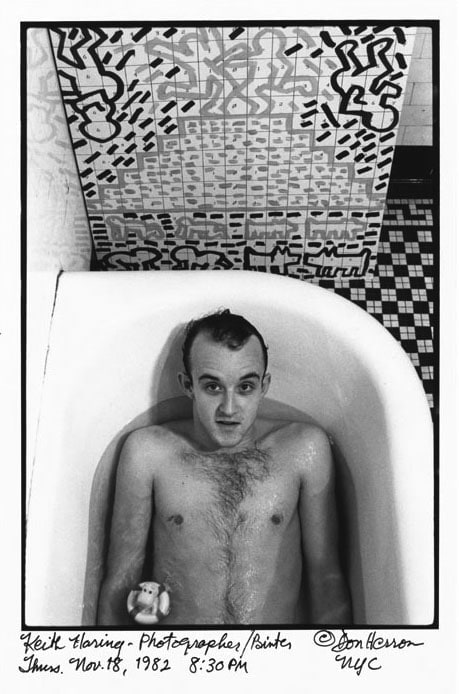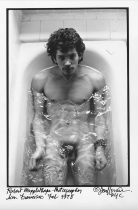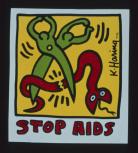Haring in a Bathtub: The Crossover We Didn't Know We Needed
Created by Kate Yoder on Sun, 03/31/2024 - 14:37
This timeline provides a sociohistorical context for Don Herron's 1982 Photo of Keith Haring.

Herron, Don. Photo of Keith Haring, 1982. https://www.danielcooneyfineart.com/artists/don-herron/featured-works. Accessed 31 March 2024.
Timeline
Chronological table
| Date | Event | Created by | Associated Places | |
|---|---|---|---|---|
| circa. 1978 |
Why Tub Shots?Don Herron moved to New York City in 1978 and became a part of the East Village art scene. Continuing his series of black-and-white images, he began to take photographs of iconic artists in their bathtubs. He photographed a variety of people, including painters, filmmakers, photographers, and even drag performers. When creating these images, he allowed the subject to have a lot of creative liberty when it came to the setup. They could decide whether they wanted to wear clothing or not, if there was water in the tub if there were any props, and pretty much anything else they wanted to do. In exchange for creative liberty, they allowed themselves to be put into an extremely vulnerable position. Being photographed in the bathtub is an intimate experience, but Herron ensured that each subject was as comfortable as possible and could make their photo unique. Herron’s goal in creating this series was to preserve and honor these artists at a time when so many were coming and going, whether it was from death or literally leaving. He wanted to capture the shifting balance between “glamour and camp, as well as joy and tragedy” (ultrawolvesunderthefullmoon.blog) that the art community in the 1970s experienced. Herron, Don. Photo of Robert Mapplethorpe, 1972. https://www.pbs.org/wnet/americanmasters/facing-death-from-aids-keith-haring-kept-creating/16169/. Accessed 31 March 2024. ultrawolvesunderthefullmoon, “Don Herron.” ultrawolvesunderthefullmoon, 1 Feb 2022, https://ultrawolvesunderthefullmoon.blog/2022/02/01/don-herron/. Accessed 31 March 2024. |
Kate Yoder | ||
| 24 Autumn 1982 to 4 Nov 1982 |
The AIDS EpidemicOn September 24, 1982, the CDC used the term “AIDS” (Acquired Immunity Deficiency Syndrome) for the first time in an MMRW (Morbidity and Mortality Weekly Report). In this report, they released the first case study definition for the disease: “A disease at least moderately predictive of a defect in cell-mediated immunity, occurring in a person with no known cause for diminished resistance to that disease.” In November of that same year, the CDC’s “Current Trends Acquired Immune Deficiency Syndrome (AIDS): Precautions for Clinical and Laboratory Staffs” provided the first set of precautions for medical staff to go by when working with people with AIDS symptoms. The information that the CDC released was critical in identifying AIDS since the previous name for the illness was GRID (Gay-Related Immune Deficiency) because of The New York Times. People had already made the association between gay men and AIDS, but this development took away the awful name that the Times had given the disease. Thousands, if not hundreds of thousands, of people were diagnosed with AIDS in the 80s, and all of them died. The 80s was a dangerous time for queer people, especially gay men, and AIDS put the queer community into an unwilling spotlight. “A Timeline of HIV and AIDS.” HIV.gov, https://www.hiv.gov/hiv-basics/overview/history/hiv-and-aids-timeline#year-1982. Accessed 31 March 2024. Haring, Keith. Stop Aids artwork, 1989. https://www.pbs.org/wnet/americanmasters/facing-death-from-aids-keith-haring-kept-creating/16169/. Accessed 31 March 2024.
|
Kate Yoder | ||
| circa. 1988 to circa. 1989 |
Haring and QueernessKeith Haring is one of the most influential pop artists of the 20th century. Through his art, he aimed to educate and advocate for safe sex and AIDS awareness. In 1988, Haring created an iconic image of a yellow figure opening a door for National Coming Out Day, which is still used today. That same year, he was diagnosed with AIDS. A year later, he started the Keith Haring Foundation to help fund organizations educating and spreading awareness about AIDS. Haring chose to face his illness with art, creating an insane amount of it. His main focus became making pieces depicting sexual acts and phallic line drawings. The point of these drawings was to bring awareness to AIDS and safe sex. In 1989, Haring exposed his life story to the public eye and told Rolling Stone what it was like to live with AIDS to combat backlash and stigma surrounding his illness. At a time when AIDS was being scrutinized by the public and being queer was generally met with violence, Haring was an incredible social activist. He was unapologetic and proud of his identity and turned his fear of his illness into courage. While he was praised by some for being so brave, he also lost friends and connections in the celebrity sphere who felt ashamed of him. Fields, Liz. “Facing death from AIDS, Keith Haring kept creating.” PBS, 19 Nov 2020, https://www.pbs.org/wnet/americanmasters/facing-death-from-aids-keith-haring-kept-creating/16169/. Accessed 31 March 2024. Haring, Keith. National Coming Out Day logo, 1988. https://opentable.lgbt/our-blog/2022/2/2/lgbt-history-month-meet-keith-haring-pop-artist-and-aids-awareness-advocate#:~:text=In%201988%2C%20Haring%20designed%20the,about%20AIDS%20through%20his%20art. Accessed 31 March 2024. “LGBT+ History Month - Meet Keith Haring, Pop Artist and AIDS Awareness Advocate.” Open Table Network, 27 Mar. 2024, https://opentable.lgbt/our-blog/2022/2/2/lgbt-history-month-meet-keith-haring-pop-artist-and-aids-awareness-advocate#:~:text=In%201988%2C%20Haring%20designed%20the,about%20AIDS%20through%20his%20art. Accessed 31 March 2024. |
Kate Yoder | ||
| 2024 |
The ConclusionThe reason I offered background concerning those three events is because they create a cohesive story about Herron’s Tub Shot of Keith Haring. The events assist me in explaining what Photo of Keith Haring was doing socially and culturally when Don Herron created it. This photo puts Haring, an incredibly outspoken and courageous activist, in a very vulnerable position. As previously noted, Haring was known for his queer activism and eventual battle with AIDS, which made him a perfect candidate for Herron’s series. Herron scoped out camp and “hippie” artists like Haring who were honest about their sexuality through their medium. This photo was taken in 1982, six years before Haring was diagnosed with AIDS. At the time of this photo, the CDC was taking steps to identify the disease and educate the public about it, despite the blatant homophobia that surrounded it. This photo shows Haring’s ability to expose himself (figuratively and literally) even though he was in such a dangerous position. Fear was a common byproduct of queerness and almost anything that wasn’t the norm, so putting Haring in this photo was a testament to queer people to keep going and keep fighting because there are people like him willing to be vulnerable for them, but that their fear is still valid. Herron’s ability to find artists that represented both joy and tragedy isn’t lost on Haring, since he ultimately did die around eight years after this photo was taken. He fit the description perfectly of a hippie artist who was living too fast, hence Herron’s choice to include him in the Tub Shots collection.
“A Timeline of HIV and AIDS.” HIV.gov, https://www.hiv.gov/hiv-basics/overview/history/hiv-and-aids-timeline#year-1982. Accessed 31 March 2024. Fields, Liz. “Facing death from AIDS, Keith Haring kept creating.” PBS, 19 Nov 2020, https://www.pbs.org/wnet/americanmasters/facing-death-from-aids-keith-haring-kept-creating/16169/. Accessed 31 March 2024. Haring, Keith. National Coming Out Day logo, 1988. https://opentable.lgbt/our-blog/2022/2/2/lgbt-history-month-meet-keith-haring-pop-artist-and-aids-awareness-advocate#:~:text=In%201988%2C%20Haring%20designed%20the,about%20AIDS%20through%20his%20art. Accessed 31 March 2024. Haring, Keith. Stop Aids artwork, 1989. https://www.pbs.org/wnet/americanmasters/facing-death-from-aids-keith-haring-kept-creating/16169/. Accessed 31 March 2024. Herron, Don. Photo of Keith Haring, 1982. https://www.danielcooneyfineart.com/artists/don-herron/featured-works. Accessed 31 March 2024. Herron, Don. Photo of Robert Mapplethorpe, 1972. https://www.pbs.org/wnet/americanmasters/facing-death-from-aids-keith-haring-kept-creating/16169/. Accessed 31 March 2024. “LGBT+ History Month - Meet Keith Haring, Pop Artist and AIDS Awareness Advocate.” Open Table Network, 27 Mar. 2024, https://opentable.lgbt/our-blog/2022/2/2/lgbt-history-month-meet-keith-haring-pop-artist-and-aids-awareness-advocate#:~:text=In%201988%2C%20Haring%20designed%20the,about%20AIDS%20through%20his%20art. Accessed 31 March 2024.
ultrawolvesunderthefullmoon, “Don Herron.” ultrawolvesunderthefullmoon, 1 Feb 2022, https://ultrawolvesunderthefullmoon.blog/2022/02/01/don-herron/. Accessed 31 March 2024. |
Kate Yoder |



